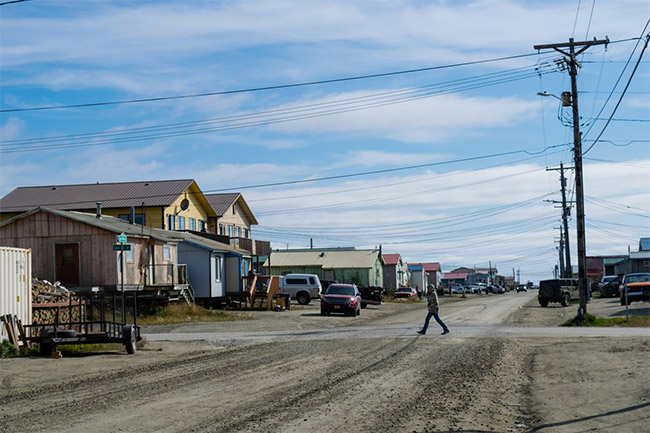Last Updated on July 18, 2023
Short Answer
Nome, Alaska, uses diesel generators and renewable energy sources. Due to its remote location, the city relies heavily on diesel generators to meet its energy needs. These generators burn diesel fuel to produce electricity. However, in recent years, Nome has also invested in renewable energy sources such as wind and solar power. These sources help reduce the city’s dependence on diesel and provide a more sustainable and environmentally friendly energy solution. Integrating renewable energy into Nome’s electricity grid is an ongoing effort to ensure a reliable and clean power supply for the community.
The Unique Energy Challenges Faced by Nome, Alaska
Nome, Alaska, a small city on the state’s western coast, faces unique energy challenges due to its remote location and harsh climate. With no road access to the rest of Alaska or the contiguous United States, Nome relies heavily on air and sea transportation for supplies, including fuel for electricity generation. This isolation makes it difficult and expensive to transport and store fossil fuels, which are currently Nome’s primary electricity source.
However, Nome is not letting its geographical challenges hold it back. The city has been actively exploring renewable energy initiatives to harness the power of nature and reduce its dependence on fossil fuels. These initiatives include the development of wind farms, solar power installations, and hydroelectric projects.
Nome aims to create a more sustainable and environmentally friendly future by embracing renewable energy sources. These initiatives reduce the city’s carbon footprint and provide economic benefits by reducing the reliance on expensive fossil fuels. Additionally, renewable energy projects can create job opportunities and stimulate the local economy.
Exploring Nome’s Dependence on Fossil Fuels for Electricity
While Nome, Alaska, has made significant strides in embracing renewable energy initiatives, it still heavily relies on fossil fuels for its electricity needs. This dependence on non-renewable resources poses several challenges for the community.
One of the main reasons for Nome’s reliance on fossil fuels is its location. Situated on the western coast of Alaska, Nome experiences harsh winters with limited daylight hours. This makes it challenging to harness solar energy, a critical component of many renewable energy systems.
Additionally, Nome’s remote location makes it challenging to access alternative energy sources. The transportation and logistics of bringing renewable energy technologies to the area can be costly and time-consuming.
Despite these challenges, Nome is actively exploring ways to reduce its dependence on fossil fuels. The community invests in research and development to find innovative solutions that provide reliable and sustainable electricity.
By diversifying its energy sources and embracing a mix of renewable and non-renewable options, Nome aims to create a more resilient and environmentally friendly energy system for its residents.
The Role of Diesel Generators in Nome’s Power Supply
To meet the electricity demands of Nome, Alaska, the city relies heavily on diesel generators. These generators play a crucial role in providing power to the community, especially when renewable energy sources are insufficient.
- Diesel generators are Nome’s primary electricity source, accounting for a significant portion of the city’s power supply.
- These generators are powered by diesel fuel, readily available in the region.
- Due to the remote location of Nome, it is not feasible to connect the city to the larger electrical grid. As a result, diesel generators are essential for meeting the community’s energy needs.
- The generators are typically housed in a centralized power plant, where trained professionals operate and maintain them.
- Diesel generators can produce electricity, making them suitable for powering homes, businesses, and other essential facilities in Nome.
- However, using diesel generators has specific challenges, including high fuel costs and environmental concerns.
Despite these challenges, diesel generators are vital in Nome’s power supply. Efforts are being made to reduce the city’s dependence on fossil fuels and transition towards more sustainable energy sources. However, until renewable energy technologies become more advanced and reliable, diesel generators will remain integral to Nome’s electricity infrastructure.
Overcoming the Isolation: Nome’s Energy Transmission and Distribution
While Nome, Alaska, faces unique energy challenges, the city has overcome its isolation through efficient energy transmission and distribution systems. Here are some key points to understand how Nome gets electricity:
- Power Grid: Nome is connected to the larger Alaska Railbelt electrical grid, allowing electricity import and export.
- Transmission Lines: High-voltage transmission lines connect Nome to the Railbelt grid, ensuring a reliable electricity supply.
- Substations: Substations are strategically located throughout Nome to regulate and distribute electricity to different city areas.
- Distribution Network: A network of power lines and transformers delivers electricity from the substations to Nome’s homes, businesses, and public facilities.
- Backup Systems: To ensure an uninterrupted power supply, Nome has backup systems, including diesel generators and battery storage systems.
- Challenges: However, the harsh Arctic climate and remote location pose challenges for maintaining and repairing the transmission and distribution infrastructure.
Despite these challenges, Nome’s energy transmission and distribution systems are crucial in providing reliable electricity to the community. Efforts are continuously made to improve and upgrade the infrastructure to meet the growing energy demands of the city.
The Future of Nome’s Electricity: Embracing Sustainable Solutions
As Nome, Alaska, continues to face the challenges of its unique energy needs, the community actively seeks sustainable solutions for its electricity supply. Recognizing the importance of reducing its dependence on fossil fuels, Nome has been exploring various renewable energy initiatives.
One such initiative is the harnessing of wind power. With its strong and consistent winds, Nome has the potential to generate a significant amount of electricity from wind turbines. The city has installed several wind turbines, and plans are underway to expand this renewable energy source.
In addition to wind power, Nome is also exploring using solar energy. Despite its northern location, Nome receives considerable sunlight during the summer months. The community can further reduce its reliance on fossil fuels by harnessing this solar energy.
Nome is actively researching the potential of hydroelectric power. With its proximity to rivers and streams, the city can generate electricity through the force of flowing water. This renewable energy source has the potential to provide a stable and consistent power supply for the community.
By embracing these sustainable solutions, Nome is taking a significant step towards a greener and more environmentally friendly future. Not only will these initiatives reduce the city’s carbon footprint, but they will also contribute to the long-term sustainability and resilience of Nome’s electricity supply.
Empowering the Community: Nome’s Efforts in Energy Conservation
As Nome, Alaska strives towards a sustainable energy future; the community has taken proactive steps in energy conservation. Recognizing the importance of reducing energy consumption, residents and businesses in Nome have embraced various initiatives to conserve electricity.
One of the critical efforts in energy conservation is promoting awareness and education. The community has organized workshops and seminars to educate residents about the importance of energy conservation and provide practical tips on reducing energy usage. These initiatives aim to empower individuals to make informed choices and adopt energy-efficient practices in their daily lives.
In addition, the community has implemented energy-saving programs and incentives. These programs encourage residents to upgrade their appliances to energy-efficient models and provide financial incentives for energy conservation measures such as insulation and weatherization. By incentivizing energy conservation, Nome is reducing its overall energy consumption and promoting economic growth and sustainability.
Furthermore, the community has embraced the concept of community-wide energy conservation. Through collaborative efforts, residents and businesses collaborate to identify and implement energy-saving measures on a larger scale. This collective approach maximizes energy savings and fosters a sense of community and shared responsibility toward a sustainable future.
Nome’s efforts in energy conservation are a testament to the community’s commitment to a sustainable energy future. By empowering individuals, implementing energy-saving programs, and fostering community-wide collaboration, Nome is making significant strides toward reducing energy consumption and embracing a more sustainable way of life.
Powering the Future: Nome’s Path to Sustainable Energy
Throughout this article, we have delved into the unique energy challenges faced by Nome, Alaska, and explored the various initiatives taken to address them. Nome’s journey towards a sustainable energy future is complex, as it requires harnessing the power of nature while overcoming the region’s isolation.
One of the key findings is the city’s heavy dependence on fossil fuels, particularly diesel generators, for electricity. However, Nome is not content with relying solely on non-renewable sources. The community has embraced renewable energy initiatives, such as wind and solar power, to reduce its carbon footprint and increase energy efficiency.
Nome’s energy transmission and distribution efforts have also played a crucial role in ensuring a reliable power supply. The city has invested in infrastructure to overcome the challenges posed by its remote location, ensuring that electricity reaches every corner of the community.
Looking ahead, Nome is committed to embracing sustainable solutions and empowering its community through energy conservation. Nome is paving the way for a greener and more sustainable future by continuing to explore renewable energy options and promoting energy-efficient practices.
Nome’s ongoing journey towards a sustainable energy future is a testament to the resilience and determination of its community. By harnessing the power of nature, overcoming isolation, and embracing sustainable solutions, Nome is paving the way for a brighter and more sustainable future.
Frequently Asked Questions
Q: What is the power source of Nome, Alaska?
A: Nome, Alaska, primarily relies on renewable energy sources and fossil fuels for its electricity supply.
Q: What are the unique energy challenges faced by Nome, Alaska?
A: Nome, Alaska, faces extreme weather conditions, geographical isolation, and limited access to traditional energy infrastructure.
Q: What renewable energy initiatives does Nome have?
A: Nome has implemented various renewable energy initiatives, including wind turbines, solar panels, and hydroelectric power, to harness the power of nature and reduce dependence on fossil fuels.
Q: How dependent is Nome on fossil fuels for electricity?
A: Despite efforts to promote renewable energy, Nome still relies heavily on fossil fuels, particularly diesel, for electricity generation.
Q: What role do diesel generators play in Nome’s power supply?
A: Diesel generators serve as a crucial backup power source in Nome, providing electricity during high demand or when renewable energy sources are insufficient.
Q: How does Nome overcome its energy transmission and distribution isolation?
A: Nome utilizes a combination of undersea and overland transmission lines and microgrids to ensure reliable energy transmission and distribution throughout the community.
Q: What does the future hold for Nome’s electricity supply?
A: Nome is actively working towards embracing sustainable solutions for its electricity supply, focusing on expanding renewable energy infrastructure and reducing reliance on fossil fuels.
Q: What efforts has Nome made in energy conservation?
A: Nome has implemented various energy conservation initiatives, including promoting energy-efficient practices, educating the community on energy conservation, and incentivizing energy-saving measures.
Q: What is Nome’s ultimate goal in terms of energy sustainability?
A: Nome is on an ongoing journey towards achieving a sustainable energy future, aiming to reduce greenhouse gas emissions, increase renewable energy generation, and ensure long-term energy security for the community.
About The Author

Wendy Lee is a pop culture ninja who knows all the latest trends and gossip. She's also an animal lover, and will be friends with any creature that crosses her path. Wendy is an expert writer and can tackle any subject with ease. But most of all, she loves to travel - and she's not afraid to evangelize about it to anyone who'll listen! Wendy enjoys all kinds of Asian food and cultures, and she considers herself a bit of a ninja when it comes to eating spicy foods.

